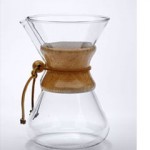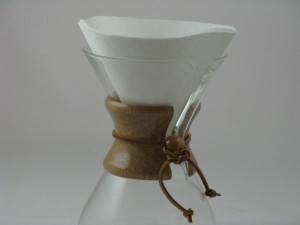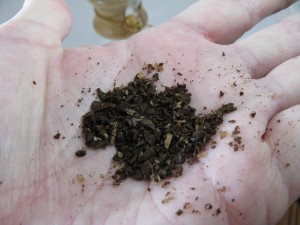The Chemex is both a coffee brewer and an artwork. Few coffee brewers have the ability to show to an audience like this brewer. It’s even earned a place at the Smithsonian. It’s so delightful to look at that it’s easy to overlook that it’s a fine coffee brewer that offers a unique flavor profile.
How It Works
The Chemex uses a thick laboratory-grade paper filter. If you try to use Melitta-style filters in a Chemex, the water will run through too quickly. The paper is part of the method. It asks as a flow regulator. The idea is to fill the Chemex with coarse ground coffee and let it soak as the thick paper slows the water’s movement through the coffee. In this way, it offers and almost-French press-like soaking to the grounds. But, most Chemex aficionados suggest tiny hot water pours, adding just enough to completely cover the grounds.
Tests
I made coffee using very coarse grounds, identical to what I’d use in a French press or percolator. This is counterintuitive to drip making, but the thick paper demands it. If you grind too finely, the combination of paper density and grind will slow your drip rate so much, you’ll end up with very strong, bitter coffee, although there will be no sediment. I heated the water to boiling and then removed it. In about a minute the water was 200 degrees Fahrenheit. That’s a good temperature to pour into the Chemex. The Chemex inventor, Dr. Peter Schlumbohm, believed that most coffee brewers (especially the vacuum) brewed at too high a temperature. The Chemex is designed to brew at standard or below temperatures. While I got good results at up to 200F, I often preferred the coffee brewed at around 190, which is technically 5 degrees below industry standards. Let’s just say this: don’t pour the water in once it’s boiling; you won’t like the results.
The temperature curve reflects the gaps between pours. As you can see, it’s hard to determine the exact contact time between the water and the grounds. One reason for the distinctive flavor of the Chemex might be the wide temperature variance once the water is poured in, without any more hot water joining it until that amount has gone through the grounds. Another reason may be the coarse grounds. The thick paper filter is almost certainly a factor. While critics may claim the Chemex filter holds back important flavor oils, I would not agree without some evidence. The cup profile does not indicate anything less than a stellar cup of coffee. In fact, I think I can make stronger coffee with the Chemex with no bitterness at least partly due to its filter. If a wine-like viscosity is what you want in your cup, the Chemex is your brewer.
Grind
The Chemex works by trial and error. It is difficult to calculate the contact time, as you really have a number of contact times, due to the practice of pouring small amounts of hot water and allowing it to cycle through the filter bed before pouring in the next one. The best starting point it simply to use a coarse grind and not-too-hot water.
Measurements
I use forty grams of ground coffee in the so-called six cup Chemex. I own the larger one too, the eight cup. I use seventy-two grams of ground coffee and I grind is slightly coarser. I use less and grind coarser because the ground coffee bed is deeper, meaning the contact time is automatically longer.
Water temperature
An interesting point how hot the succeeding pours are. Most manual drip users boil the water, then let it come off the boil and then pour it in without reheating it. As Oren Bloostein told me, he continuously keeps the water at near boiling. I’ve done it both ways, and am unconvinced that one way is inherently right versus the other. I suggest you try both and decide.
Cleanup is simpler with the Chemex than any other brewer I’ve used. You simply toss the paper away. If you compost, you toss the remove the grounds and toss the filter. The glass maker rinses easily — nothing to scrub.
Conclusion
The Chemex is the most attractive manual drip maker ever made. It is a manual drip maker, which means it’s more work to make the coffee. Even though I do, I can understand others claiming they don’t want to make manual coffee while getting ready in the morning. Its cleanup is so simple, and once you get your measurements and grind down, it’s really quite an easy brewer. The only thing left is how to keep the coffee warm. I suggest the cost is low enough that you buy two sizes and make the right amount for a half hour, and spring for the glass top that keeps the heat in.
I strongly recommend the Chemex brewer.





Kevin
With 40g of coffee, hoe much water should i boil?
Thanks
Jay
Hi Jay,
40 grams of coffee should roughly equal four 6 ounce cups or 24 ounces water. Sorry to mix metric and English measurements but you get the idea. Be cautious not to overgrind with a Chemex. They seem to do best with coarser-than-average grinds.
Hi Kevin
I have all four hand blown models (3 cup, 6 cup, 8cup and 13 cup) I would like to give two as gifts and retain two, Maybe even one obly to keep. Is there an ideal size? My brewing needs are maily 15 to 30 ounces, but they can be as high as 50 ounces.
Thanks
Jay
Hi Jay,
They’re all great. For me the ideal size is the six cup. It really works out to about five 6-ounces cups. But each has its place.
I actually have a vintage Chemex brewer with integral warming plate that heats the water to just the right temperature and dispenses it in increments that vary depending on the amount of water. I always think its done and, oops, one more shot. Superb coffee. I don’t know why they no longer make this.
I am also lucky enough to have a Chemex electric warming plate that I use to keep it warm during breakfast on my covered veranda. My older carafes came with a little metal heat disperser for use on electric elements and I also recall using the asbestos ones (gasp) as a teenager…Chemex still rules.
Love your site, but am having trouble finding a search option. I came here for info on the Vaculator. Just bought one yesterday.
CTD
The electric automatic drip Chemex is a wonderful machine, Teresa. As far as I know it’s the first to have interval brewing – that is it gets the water hot, drips a few ounces over the grounds, and then shuts down while that portion drips through before heating and releasing more water. Perhaps the closest you can get to how you brew with a kettle. I have attempted to talk Chemex’s owner Liz Grassy into redoing that machine, but so far it hasn’t happened. I’ll have to check into a search option. Good idea. Now, I’ll have to go brew some coffee in that Chemex.
Hi Kevin
With the six cup glass handle Chemex, Can you brew just 10-12 ounces? I tried the c cup and find it hard to work with.
Thanks
Jay Fischer
You can always brew less, but you need to vary the grind in order to prolong the extraction time. Takes some futzing, but yes, it’s possible.
Hello-
Do you use the unbleached, brown Chemex filters, or the bleached white ones? Circle or square?
Thanks!
cc
Hello Carole,
I use the so-called bleached ones. I have never detected any flavor added due to it. I suspect they are using an inert substance such as Hydrogen Peroxide. No one I know of currently uses Chlorine Bleach. Meanwhile, sometimes when using the so-called natural brown filters I do get what I describe as a wet shopping bag aroma and tasting note. It is not so pronounced that I would waste filters I already owned, but enough that I would always default to ordering white filters unfailingly.
Hope this is helpful.
Warm regards,
Kevin
The Chemex is 100% glass. No steel. No plastic. In my experience glass is virtually free from any trace of a previous brew’s aromas or flavors. Are you sure you meant to post this comment here, Adriana?
Hi Kevin
I have both what Chemex calls the “5 cup” hand-blown and the “8 cup” hand-blown. The upper portion on the “8 cup” is both wider and deeper. Do I need to vary the grind between these two brewers? Square or circle filters?
Thanks
Jay
Hi Jay,
Thank you for your question, which is a very good one. I’m going to go out on a limb and say the grind for Chemexes is something of a mystery. I play it by ear, as well as grounds to water ratios. I use the 5 cup hand-blown most of the time. I use 50 grams of coffee and number 8 on my Ditting grinder. When I switch to the 8 cup hand-blown I usually coarsen the grind a half notch to 8.5 and use 80 grams. I always fiddle with the grind when I switch coffees, but rarely more than a 1/4 notch either way. I vary grind before I vary ratios. If it wasn’t the best coffeemaker ever, I might not go to all this trouble, but obviously many agree the Chemex is a truly marvelous way to brew.
Hope this is helpful.
Kevin
Thanks Kevin
In the smaller Chemex ( 5 cup hand blown or 6 cup with glass handle) can you make less than the full capacity? I am looking to make 10-13 ounces. I have tried the 3 cup and find it awkward, given my “dexterity”. What would you modify to get a smaller brew with the 5-6 cup? I have tried several of the drip cones and I find the chemex easier to work with. What do I need to modify for a smaller batch? Grind coarseness? Amount of coffee ? Both? I do well when brewing two large mugs or more but struggle with adapting for one large mug.
Thanks
Jay
Hi Jay,
Yes, you can make smaller batches than a full one. You must play with the grind and/or ratio. You must engineer your recipe so the contact time remains the same or the grind gets finer or coarser to adjust to a shorter or longer contact time.
It is not necessarily intuitive nor easy. Fortunately the rewards in the cup often justify it.
Warmly,
Kevin
Thanks
Thanks Kevin
There appears to be CoffeeCon in NYC, but when one goes to the web one cannot register yet.
Jay
Hi Jay,
No, registration has not opened yet. I will suggest they add an alert so you can get a ticket right away.
Kevin
Kevin
Getting back to Chemex. It looks like you use the bleached circle filters rather than the square ones. Any advantage to the circles?